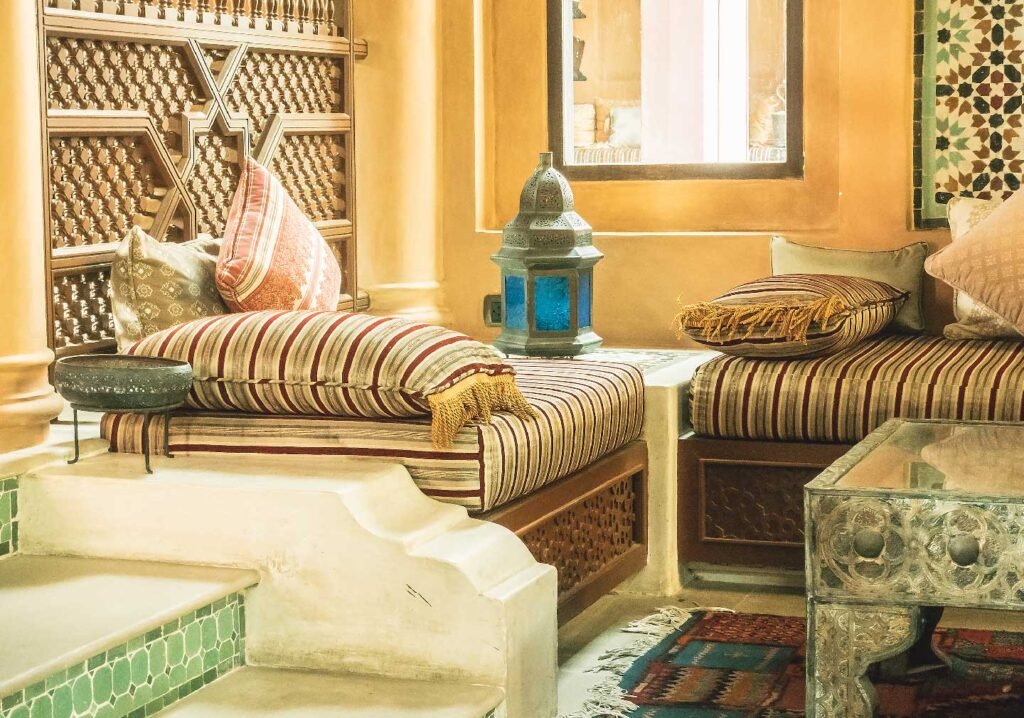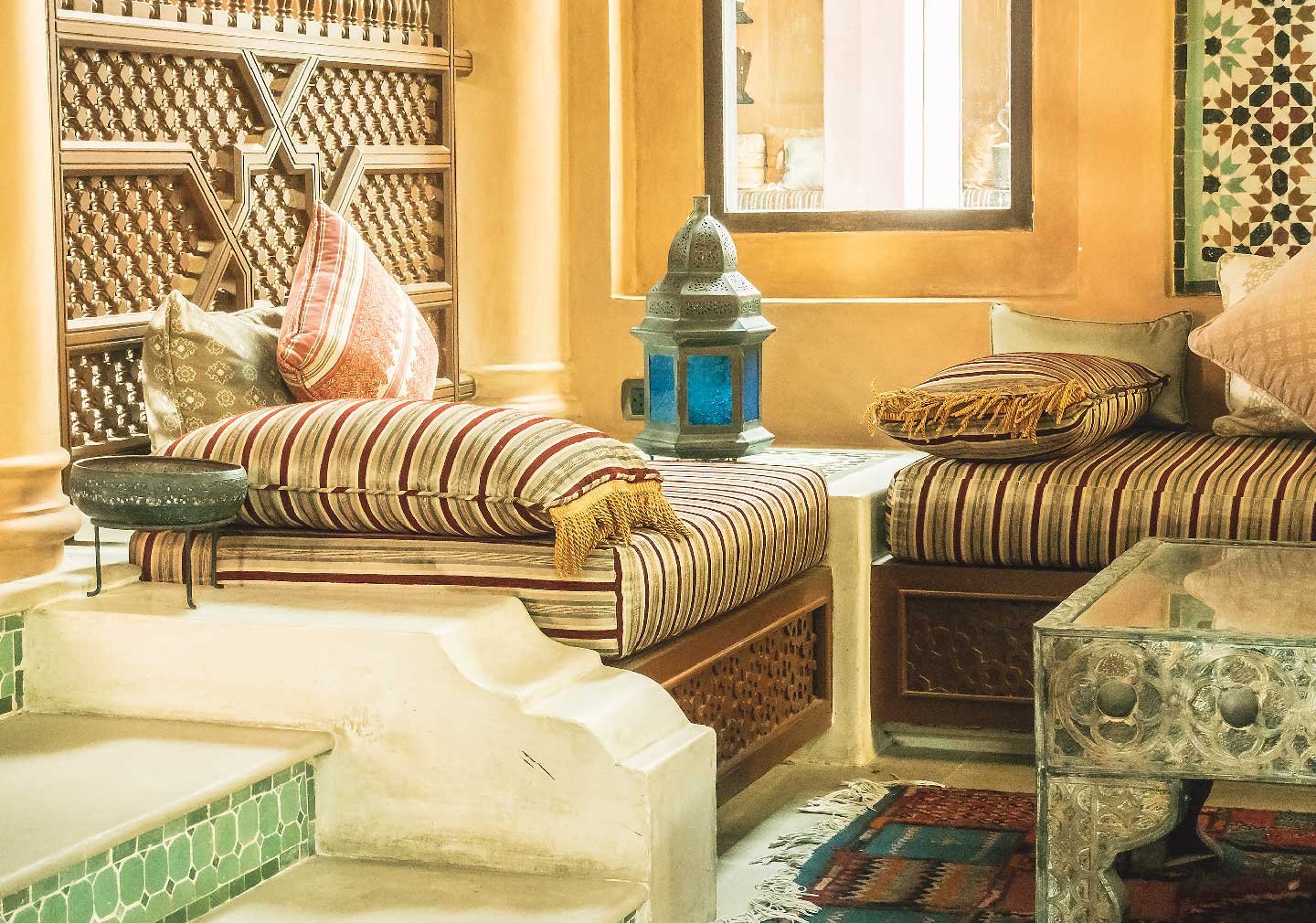
The allure of Moroccan design lies in its rich tapestry of history, culture, and craftsmanship. From the bustling souks of Marrakech to the tranquil riads of Fez, Moroccan textures bring warmth, depth, and an unmistakable exotic charm to any space. Incorporating these elements into your home doesn’t require a complete overhaul—simple, intentional touches can transform your interiors into a vibrant oasis. This article explores easy, accessible ways to weave Moroccan textures into your living spaces, blending traditional artistry with modern sensibility. Whether you’re drawn to intricate tilework, plush fabrics, or earthy materials, these techniques will inspire you to create a home that feels both timeless and uniquely yours. Let’s dive into the sensory world of Moroccan design and uncover practical steps to make it part of your everyday life.
Understanding the Essence of Moroccan Textures
Moroccan design is a celebration of tactile beauty. Think handwoven rugs with geometric patterns, carved wooden furniture, and ceramic tiles painted with swirling arabesques. These textures reflect centuries of Berber, Arab, and Andalusian influences, merging bold colors with intricate details. The key to integrating them lies in balance—pairing their richness with minimalist surroundings to avoid overwhelming your space. Start by identifying areas in your home that could benefit from a touch of warmth or visual interest, such as a bare wall, a neutral sofa, or an uninspired corner. Moroccan textures thrive on contrast, so they work especially well in modern homes craving personality. By understanding their roots, you can thoughtfully adapt them to suit your style without losing their authentic spirit.
Layering Rugs for Instant Moroccan Flair
One of the simplest ways to introduce Moroccan texture is through rugs. Traditional Berber rugs, with their thick wool piles and abstract designs, are perfect for adding coziness underfoot. Opt for a neutral-toned rug with pops of color like saffron or indigo to anchor a living room or bedroom. For a bolder statement, try a shag-style rug with tassels, reminiscent of Moroccan bazaars. Layering is a classic technique—place a smaller, patterned rug over a larger, solid one to create depth. This not only enhances texture but also defines a space, like a reading nook or dining area. To source authentic pieces, explore sites like West Elm, which offers Moroccan-inspired rugs that blend tradition with contemporary appeal. Maintenance is easy—regular vacuuming keeps them vibrant for years.
Incorporating Moroccan Tiles Without Renovation
Moroccan tiles, or zellige, are iconic for their handcrafted imperfections and glossy finishes. While installing them in a kitchen or bathroom is a dream, you can mimic their effect without permanent changes. Peel-and-stick tiles in geometric patterns offer a renter-friendly alternative, ideal for a backsplash or accent wall. Alternatively, use decorative tile stencils to paint a faux tile design on a plain surface—think a fireplace surround or a staircase riser. Choose earthy tones like terracotta, teal, or mustard to capture the Moroccan palette. For inspiration, The Spruce provides tutorials on DIY tile projects that replicate this look affordably. These methods bring the intricate charm of zellige into your home, proving that texture doesn’t always require a contractor.
Weaving in Textiles for Soft Moroccan Vibes
Textiles are the heartbeat of Moroccan interiors, softening hard edges with luxurious fabrics. Swap out plain throw pillows for ones with embroidered details or metallic threads, evoking the opulence of a Moroccan riad. Blankets with fringed edges in rich hues like burgundy or olive can drape over a chair or sofa, adding instant texture. Curtains in lightweight cotton or silk with subtle patterns can frame windows, filtering light with a gentle, exotic touch. Visit Anthropologie for curated Moroccan-inspired textiles that blend seamlessly into modern decor. Mix and match patterns—stripes with florals or diamonds with zigzags—to embrace the eclectic Moroccan aesthetic. These soft additions not only elevate comfort but also invite a sensory experience rooted in tradition.
Adding Carved Wood for Rustic Elegance
Woodwork in Moroccan design often features intricate carvings, from door frames to furniture. You don’t need a custom piece to capture this texture—small accents can make a big impact. A carved wooden mirror above a console table reflects light and adds sophistication. Look for trays or boxes with lattice patterns to use as coffee table decor or storage. Thrift stores or online marketplaces like Etsy often have handmade Moroccan wood pieces at reasonable prices. For a DIY approach, distress a plain wooden frame with sandpaper and stain it in a warm tone like walnut, mimicking the aged look of Moroccan craftsmanship. Position these items strategically—a shelf or entryway—to draw the eye without cluttering your space.
Bringing in Metallic Accents for Subtle Shine
Moroccan interiors shimmer with metallic finishes, thanks to brass lanterns and silver trays. These elements catch light and add a layer of texture through their reflective surfaces. Start small with a brass candleholder or a hammered metal vase on a side table. For a statement piece, hang a Moroccan-style lantern above a dining table—its perforated design casts intricate shadows, enhancing ambiance. You can find affordable options at World Market, where Moroccan-inspired decor balances authenticity and accessibility. Avoid overdoing it—two or three metallic touches per room keep the look cohesive. Pair them with matte surfaces like clay pots or linen upholstery to highlight their gleam, creating a harmonious blend of textures that feels both luxurious and grounded.
Using Clay and Ceramics for Earthy Depth
Clay pots and ceramic vessels are staples in Moroccan homes, offering a raw, organic texture. A large terracotta planter with a succulent can anchor a corner, while smaller ceramic bowls in jewel tones work as catchalls on a kitchen counter. Look for pieces with hand-painted designs or subtle glaze variations to echo Moroccan artistry. Retailers like Pottery Barn offer collections inspired by North African aesthetics, blending durability with style. Group these items in odd numbers—three or five—for a natural, curated feel. Their earthy presence contrasts beautifully with smoother surfaces like glass or metal, grounding your space in the rugged beauty of Morocco’s landscapes and traditions.
Comparison Table: Moroccan Texture Elements
| Element | Texture Type | Ease of Use | Cost Range |
|---|---|---|---|
| Rugs | Soft, plush | High (lay and style) | $50–$300 |
| Tiles | Hard, glossy | Medium (DIY options) | $20–$100 |
| Textiles | Soft, woven | High (swap easily) | $15–$80 |
| Carved Wood | Hard, rustic | Medium (sourcing) | $30–$150 |
This table highlights how each texture contributes to your home and its practicality, helping you prioritize based on budget and effort.
Playing with Patterns for Visual Texture
Patterns are a cornerstone of Moroccan design, turning flat surfaces into dynamic focal points. Wallpaper with a trellis or star motif can transform a small powder room or accent wall. If commitment isn’t your style, try removable decals or fabric panels hung as art. Mix patterns sparingly—combine a bold rug with a subtler pillow design to avoid chaos. For guidance, HGTV offers tips on balancing patterns in eclectic decor. The goal is controlled vibrancy—let one piece shine while others support it. This approach builds visual texture that feels intentional, drawing the eye without overwhelming the senses.
Creating Ambient Lighting with Moroccan Lanterns
Lighting in Moroccan homes isn’t just functional—it’s an art form. Lanterns with cutout patterns cast mesmerizing shadows, adding texture through light itself. Hang a single lantern in a hallway or cluster smaller ones on a patio for a magical glow. Battery-operated versions work for spaces without wiring, offering flexibility. Pair them with warm bulbs to enhance the golden tones typical of Moroccan evenings. The interplay of light and shadow mimics the ambiance of a desert night, making your home feel both cozy and exotic. This subtle addition ties together other textures, amplifying their impact.
FAQs About Adding Moroccan Textures to Your Home
What defines a Moroccan texture?
Moroccan textures blend natural materials like wool, clay, and wood with intricate detailing—think woven rugs, carved furniture, or hand-painted tiles. They’re tactile and visually rich, rooted in cultural heritage.
Can I mix Moroccan textures with other styles?
Absolutely. Pair them with Scandinavian minimalism for contrast or bohemian decor for synergy. The key is moderation—let Moroccan elements stand out against simpler backdrops.
How do I maintain Moroccan textiles?
Spot-clean rugs and pillows with mild detergent, and air them out regularly. For durability, choose synthetic blends inspired by traditional wool if pets or kids are a factor.
Where can I find affordable Moroccan decor?
Online retailers like Etsy, World Market, or Anthropologie offer budget-friendly options. Thrift stores and local artisan markets are also treasure troves for unique finds.
Conclusion: Building Your Moroccan-Inspired Sanctuary
Infusing your home with Moroccan textures is about more than aesthetics—it’s an invitation to slow down and savor the beauty of craftsmanship. From layering rugs to hanging lanterns, these easy techniques let you experiment without commitment, blending the exotic with the everyday. Start small with a carved tray or a patterned pillow, then build as your confidence grows. The result is a space that tells a story—of distant markets, ancient traditions, and your own creative vision. By thoughtfully integrating these elements, you craft a home that’s not just stylish but soulful, a personal retreat echoing the timeless allure of Morocco. For more ideas, explore Architectural Digest to see how global design trends can inspire your next step. Your Moroccan haven awaits—begin today.

